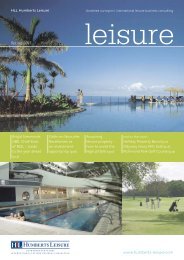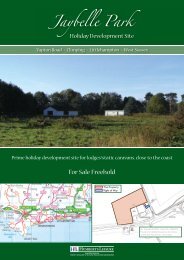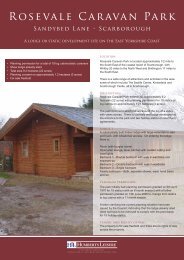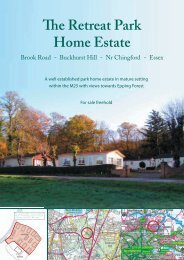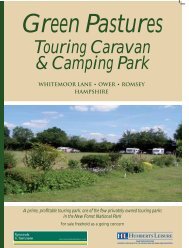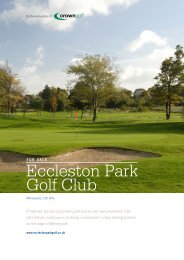0835 Leisure Summer 08_aw.indd - HLL Humberts Leisure
0835 Leisure Summer 08_aw.indd - HLL Humberts Leisure
0835 Leisure Summer 08_aw.indd - HLL Humberts Leisure
- No tags were found...
You also want an ePaper? Increase the reach of your titles
YUMPU automatically turns print PDFs into web optimized ePapers that Google loves.
NewsQueen’s Pier, Ramsey, Isle of ManHotel developmentobstacles overcome<strong>HLL</strong> <strong>Humberts</strong> <strong>Leisure</strong> is constantly involved in looking for suitablesites on behalf of hotel and leisure developers or operators wishingto have a presence in various markets within the UK. Requirementsdo vary from operator to operator and brand to brand but, as arule of thumb, key requirements include location, land availability,likelihood of achieving planning consent, strength and characteristicsof the market, viability, development costs and land values.Once a hotel developer or operator has identified suitable locationsand sites which meet their specific requirements, they can oftencome up against real or perceived barriers which hinder thedevelopment process. An increasingly real obstacle to developmentis often linked to obtaining planning permission, particularly forout-of-centre sites and, in particular, at sites located in or near to theGreen Belt, Areas of Outstanding Natural Beauty, conservation orheritage areas. This is becoming increasingly common as competitionfor sites intensifies and the availability of suitable sites diminishes.<strong>HLL</strong> provides consultancy and planning advice to clients in orderto overcome these obstacles and satisfy planning requirements.An important planning requirement is often to prove need foradditional hotel rooms (both qualitative and quantitative) and toaddress national planning policy relating to new hotel development– outlined in Planning Policy Statement 6 (PPS6), Planning PolicyStatement 7 (PPS7) and the Good Practice Guide on Planningfor Tourism. PPS6 requires a Sequential Site Assessment whichassesses the proposed site relative to other potential sites froma locational, market and planning perspective. Local PlanningAuthorities, however, tend to apply PPS6 indiscriminately to allhotel development proposals even though it may not be applicable tocountryside or roadside hotel proposals.The Consultancy and Public Sector Development team at <strong>HLL</strong>can truly provide clients with a one stop shop to developers andoperators requiring prudent advice to overcome these obstacles.<strong>HLL</strong> has provided planning policy and market evidence in supportof planning applications and expert witness at planning inquiries atvarious locations across the UK, including very recently projects inCambridgeshire, Heathrow, Oxfordshire, Essex and Kent.ContactNigel Mills MBHA, Brightone: nigel.mills@humberts-leisure.com t: +44 (0)1273 325 911Martin Taylor BA(Hons) BTP MRTPI MIED MTS, Brightone: martin.taylor@humberts-leisure.com t: +44 (0)1273 325 911Unrivalled among our piersPleasure piers were first built in England during the nineteenthcentury. The surge in popularity for many coastal resorts during theVictorian era led to the construction of a large number of piers. Manypiers were built to counteract tidal changes and ensure that the searemained visible to visitors at all times. Pleasure piers often include arange of facilities such as fun fairs, theatres and night clubs.In recent decades however, the decline of the traditional seasideresort and the cost of maintaining such piers has led to the gradualdecay of many such structures. Indeed, the Piers Society estimatethat there are just 55 pleasure piers remaining in existence aroundthe UK today.As finding sufficient funds to pay for the upkeep of pleasure piershas hit Local Authority and private owners hard, so many havesought to diversify and develop new income streams. Some – suchas Brighton’s Palace Pier – have been extremely successful. Others,however, have not.<strong>HLL</strong> <strong>Humberts</strong> <strong>Leisure</strong>’s Public Sector Development team hasrecently undertaken several pier-based studies to examine theviability of existing piers to help ensure that such historic structuresare maintained for future generations to enjoy.The Queen’s Pier in Ramsey on the Isle of Man was closed to thegeneral public on safety grounds in 1991. <strong>HLL</strong> <strong>Humberts</strong> <strong>Leisure</strong>was commissioned by the Isle of Man Government to review theavailable options for the Queen’s Pier and to make recommendationsas to its future use. We considered a range of commercialdevelopment options, taking into account a survey of local residentsundertaken by BMG in conjunction with our study. We provided anumber of viable development options to the Government and alsorecommended that consideration should be given to the potential fordeveloping a new leisure marina adjacent to the pier.More recently, <strong>HLL</strong> <strong>Humberts</strong> <strong>Leisure</strong> has been commissioned byBrighton & Hove Council to advise on the development potentialof the disused arches adjacent to the decaying West Pier. Thedevelopment of the proposed Brighton i360 visitor attraction has ledto a need to redevelop the pier’s immediate environs and generatefunds for the Council which could be put towards the restoration ofthe West Pier. We are currently working on a number of commercialdevelopment options, ranging from beach chalets to café/restaurantusage and the potential to create a new Artist’s Quarter in this keycentral location.Our team has extensive experience of providing advice across a widespectrum of tourism and leisure property. For further informationplease contact Peter Sharp at the Brighton office.ContactPeter Sharp BA(Hons) MBHA, Brightone: peter.sharp@humberts-leisure.com t: +44 (0)1273 325 9118 <strong>Summer</strong> 20<strong>08</strong>






